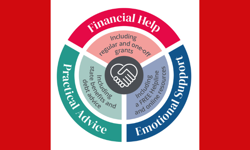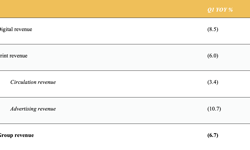One subject has caused a bit of a stir in the Chisholm kitchen. An interesting report from ComScore highlights that women are far greater users of social networks than men, and hurtling toward being more enthusiastic users of the web in general. My wife tells me it’s because women are more sociable animals. I tried suggesting it’s because women have nothing better to do, where we men have got important matters to deal with like writing learned articles, football, and going to the pub where the real social network exists. And of course that went down like a lead balloon.
It’s funny how history seems to repeat itself. Back in 2004, I produced a report that examined what made the world’s most successful newspapers, in terms of circulation growth, successful. One key factor was female readership. Of the newspapers studied, the vast majority of them had more female readers than men. That was and remains very unusual, and at the time it surprised me, but things are changing.
Newspapers historically have always been perceived as a male medium, so I thought I’d up-date myself on the state of female readership. (And forgive me for the rather confusing stats that follow.) For example, in the USA in 2009, 47% of men read a newspaper compared to 44% of women; a difference of 3% compared with 62% of men and 55% of women 10 years ago. In Japan, there’s a 2% difference compared with a massive 25% ten years ago. In the UK, the difference is 3% compared with 4% 10 years ago. In Germany, strangely, newspapers are more popular with men by 3%, compared with a 2% difference ten years ago. Australia is an exception. Today newspapers reach a higher percentage of women than of men, with women ahead by 2%. Women were 9% behind ten years ago.
What is interesting is that those countries that have made the most progress with female readers are also the ones with the best circulation performance. Germany has made least progress, with the female factor falling by 1%. Circulation is well down, by 20%. Japan has made the most progress, and sales have fallen least, by 7%.
So perhaps it’s not surprising that female usage is becoming an increasingly dominant factor online as well. The New York Times reported, back in 2008, on the growing usage in access and time spent among female users. A recent article on About.com quoted research from Pew and Forrester: “Men go online to be entertained and hunt down information, where women tend to go online to gather information that assists them in nurturing themselves and those around them. Clearly while both men and women generally spend allotments of time online, gender stereotypes are prevalent in what they do with their time online.”
The recent ComScore research found that while men were more likely to use the Internet, women spent 8% more time online, averaging 25 hours per month on the Web. Globally, women spend 20 percent more time on retail sites overall than men. In the U.S., women are more avid online buyers than men, with 12.5 percent of female Internet users making an online purchase a month, compared to 9.3 percent of men. Health sites show some of the largest overall differences in reach between female and male, with a nearly 6-point gap between global women and men.
The survey also found the differences had strong geographic differences. “Interestingly, there appears to be a correlation between a region’s percentage of online females using social networks and its gender gap. The narrowest gender gap exists in Latin America, where the percentage of female social networkers is about 2.4% higher than the percentage of male social networkers. That gap rises to 3.8% in North America, 6.2% in Europe, and 8.3% in Asia Pacific.”
Gender stereotyping is dangerous enough, without drawing geographic comparisons, but what is clear is that gender targeting is a vital tool, for four reasons:
• Clearly men and women have very different interests and demands from their media. For example women are three times as likely to play puzzle games online.
• All the available evidence suggests that for news media – indeed for media in general – targeting a female audience can have a remarkable impact on their growth.
• Thirdly research suggests that 80% of domestic purchasing spend is controlled by the women in the household (I hesitate to say that I thought it was all of it, particularly after the debacle in the kitchen).
• Women are a geometric value creator – audience, times time spent, times spending power, times acceleration.
One staggering example of the female factor is the growth of the UK Daily Mail website. The Daily Mail is perhaps the world’s leading publishing example of the power of gender targeting. Certainly in Western markets it must be regarded as the most successful newspaper in the last thirty years, built on a slogan: “Every woman needs her Daily Mail.” It was a latecomer to the digital world, but it took on outstanding web services such as the Telegraph and Guardian, with a strongly female agenda, and is now trouncing them, with their latest audience figures showing that its online audience has risen by 44% in the last year, to a position which is more than 50% above its rivals in terms of unique users and is possibly double in terms of visits – again confirming women’s stronger attachment to the web.
So what are the lessons from this?
The statistical lesson is that for the reasons described above, publishers should have a clear though not exclusive focus on their female audience. A female focus fits well with a newspapers’ relationship with its market and the range of services it can deliver: community, family, health, social well-being and entertainment, together with revenue potential from women’s 80% control of household expenditure. The content services should therefore be built around the drivers of this interaction. These emphasise participation and networking.
However the lesson from the Facebook / Google comparison is that Facebook may be getting the eyeballs, but Google continues to get the cash.
The challenge for publishers is not only to appeal more to women, but also to wrestle their 80% control of the household budget.
Sounds familiar?










